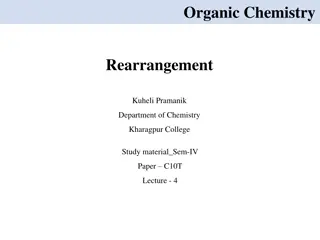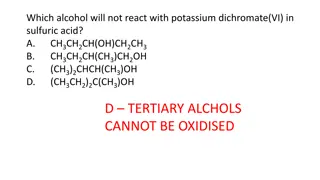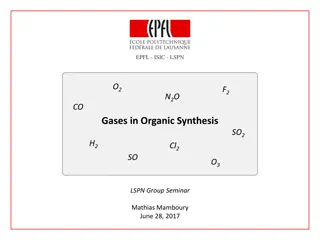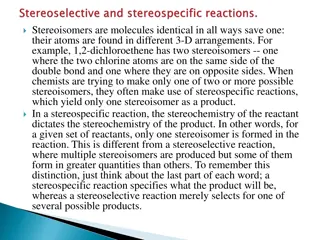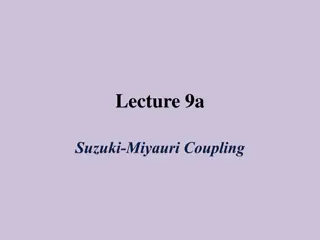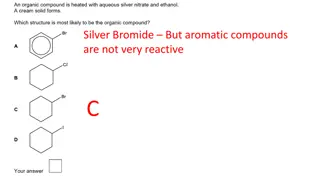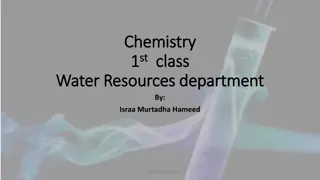Overview of Organic Chemistry Rearrangement Reactions
Explore different rearrangement reactions in organic chemistry such as Curtius rearrangement, Lossen rearrangement, and Schmidt rearrangement. Understand the mechanisms, applications, and examples of these reactions in synthesizing various compounds like isocyanates, amines, and urea derivatives.
Download Presentation

Please find below an Image/Link to download the presentation.
The content on the website is provided AS IS for your information and personal use only. It may not be sold, licensed, or shared on other websites without obtaining consent from the author. Download presentation by click this link. If you encounter any issues during the download, it is possible that the publisher has removed the file from their server.
E N D
Presentation Transcript
Organic Chemistry Rearrangement Kuheli Pramanik Assistant Professor Department of Chemistry Kharagpur College
Organic Chemistry Curtius Rearrangement The Curtius Rearrangement is the thermal decomposition of carboxylic azides to produce an isocyanate in an inert solvent. These intermediates may be isolated, or their corresponding reaction or hydrolysis products may be obtained. The reaction sequence including subsequent reaction with water which leads to amines is named the Curtius Reaction. This reaction is similar to the Schmidt Reaction with acids, differing in that the acyl azide in the present case is prepared from the acyl halide and an azide salt.
Organic Chemistry Mechanism Acyl azide Isocyanate Preparation of acyl azide DPPA = diphenylphosphoryl azide
Organic Chemistry Photochemical Curtius rearrangement The Curtius rearrangement can takes place in presence of light also. The migration occurs with full retention of configuration at the R-group. The migratory aptitude of the R-group is roughly tertiary > secondary ~ aryl > primary. The isocyanate formed can then be hydrolyzed to give a primary amine or undergo nucleophilic attack with alcohols and amines to form carbamates and urea derivatives respectively. urethane R'OH Hydrolysis HOH substituted urea
Organic Chemistry Lossen Rearrangement The Lossen rearrangement is the conversion of a hydroxamate ester to an isocyanate, catalyzed by heat, acid or base. Typically O-acyl, sulfonyl, or phosphoryl O-derivative are employed. The isocyanate can be used further to generate ureas in the presence of amines or generate amines in the presence of H2O. Hydroxamate ester
Organic Chemistry Mechanism The hydroxamic acid or ester forms isocyanate in presence of acid or base, hydrolyses to carbamic acid, which does not exist in the aqueous solution and decomposes to amine.
Organic Chemistry Examples Synthesis of Epicamphor Epicamphor
Organic Chemistry Schmidt Rearrangement The Schmidt reaction is an organic reaction in which an azide reacts with a carbonyl derivative, usually an aldehyde, ketone, or carboxylic acid, under acidic conditions to give an amine or amide, with expulsion of nitrogen. The reaction is superior to the Curtius or Hofmann rearrangement because it directly converts an acid or ester to amine, without making the acid derivatives. The reaction is limited to acid insensitive compounds. The reaction is effective with carboxylic acids to give amines, and with ketones to give amides.
Organic Chemistry Mechanism
Organic Chemistry The reaction proceeds with faster rate with sterically hindered acids which forms acyl cation in presence of acids, even without heating. acyl cation Crowding around the center of the R group facilitates the formation of acyl cation, thus enhances the rate. Acids that do not form acyl cation react through the protonation of the acid under heating, as shown previously.
Organic Chemistry Examples Cyclic ketones gives lactams with expansion of the ring
Organic Chemistry Schmidt Rearrangement for ketone
Organic Chemistry Evidence for the carbocation intermediate formation Formation of the carbocation step (6) in Schmidt reaction can be evidenced by the formation of the tetrazole (A) and the substituted urea (B), which are often isolated from the reaction medium when excess of azide is used. These products are obtained from the intermediate carbocation as the amide does not react with hydrogen azide in the reaction condition. (A) (6) (B) Unsymmetrical ketone gives a mixture of two product
Organic Chemistry Beckmann Rearrangement Beckmann rearrangement is a rearrangement of an oxime functional group to substituted amides. The rearrangement has also been successful performed on haloimines and nitrones. Cyclic oximes and haloimines yield lactams. The Beckmann rearrangement is often catalyzed by acid, however other reagents have been known to promote the rearrangement. These include tosyl chloride, thionyl chloride, phosphorus pentachloride, phosphorus pentoxide, triethylamine, sodium hydroxide, trimethylsilyl iodide among others.
Organic Chemistry Mechanism The most common reaction mechanism of the Beckmann rearrangement consists generally of an alkyl migration anti-periplanar to the expulsion of a leaving group to form a nitrilium ion. This is followed by solvolysis to an imidate and then tautomerization to the amide
Organic Chemistry Evidence for anti-migration It is found that the migration of the group from the carbon atom to electron deficient nitrogen atom does not depend on the migration aptitude of the migratory group. Instead it depends on the orientation of the group. The migration always takes place from the anti position to the leaving group. Thus the reaction is highly stereospecific. K1>K2 as migration aptitude of Ph>Me
Organic Chemistry Evidence for intramolecular type rearrangement The rearrangement is intramolecular. When -center of migrating group is chiral, it retains its configuration in the product also. Retention of configuration When a mixture of different oximes are reacted in presence of acid, no cross products are obtained, which again confirms the intramolecular nature of the rearrangement. No cross products
Organic Chemistry Beckmann fragmentation The Beckmann fragmentation is a reaction that frequently competes with the Beckmann rearrangement. When the group to the oxime is capable of stabilizing carbocation formation, the fragmentation becomes a viable reaction pathway. The reaction generates a nitrile and a carbocation, which is quickly intercepted to form a variety of products. The nitrile can also be hydrolyzed under reaction conditions to give carboxylic acids. Different reaction conditions can favor the fragmentation over the rearrangement Quaternary carbon centers promote fragmentation by stabilizing carbocation formation through hyperconjugation. As shown in the above picture, the "stable" carbocation is formed, which then loses a hydrogen to give a site of unsaturation.
Organic Chemistry Examples Oxygen and nitrogen atoms also promote fragmentation through the formation of ketones and imines respectively. An industrial synthesis of paracetamol involves the conversion of a methyl ketone to an acetanilide via a Beckmann rearrangement. Beckmann rearrangement paracetamol
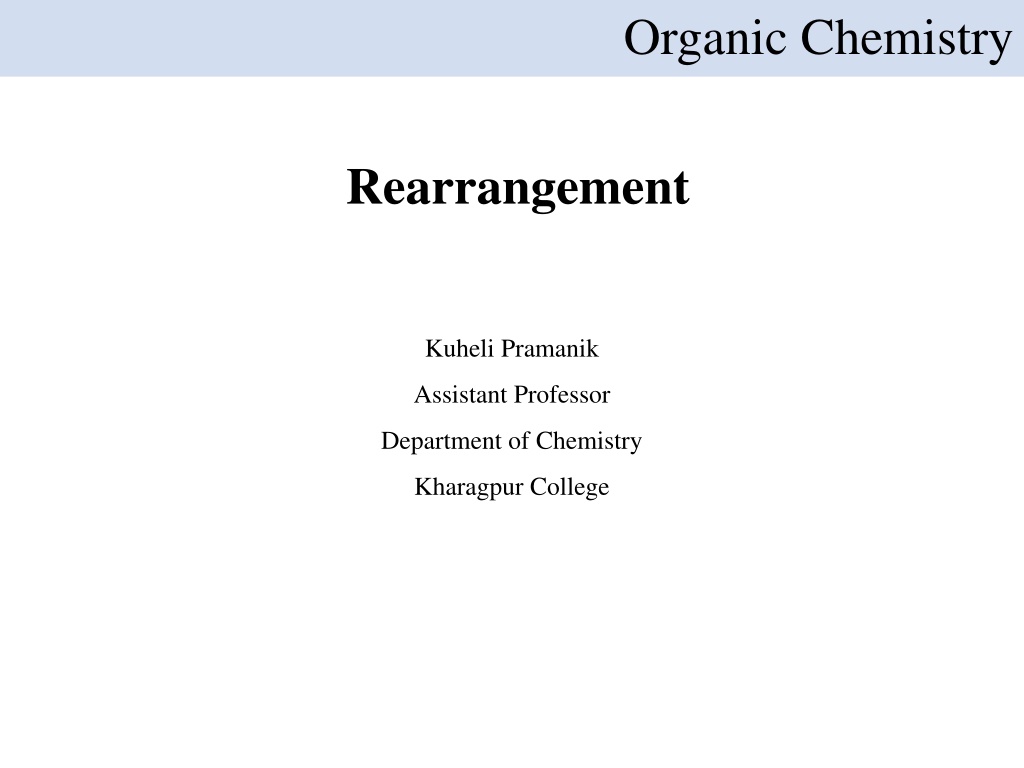

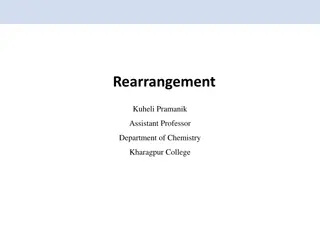
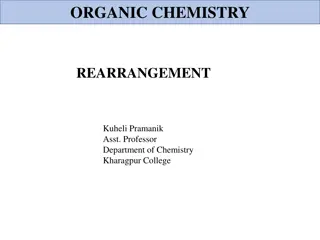
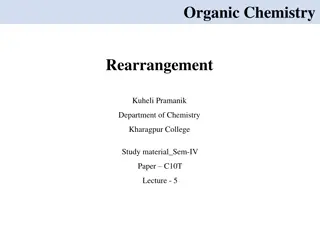
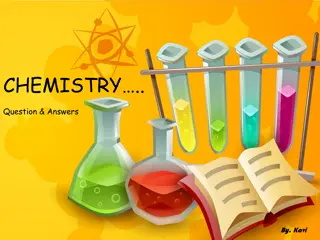
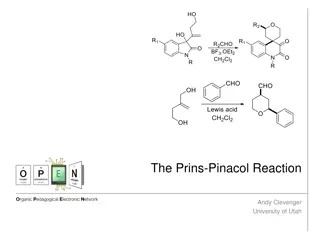
![The Synthesis of Cedranoid Sesquiterpenes via Photo-Rearrangement of Bicyclo[2.2.2] Octenones](/thumb/198279/the-synthesis-of-cedranoid-sesquiterpenes-via-photo-rearrangement-of-bicyclo-2-2-2-octenones.jpg)
